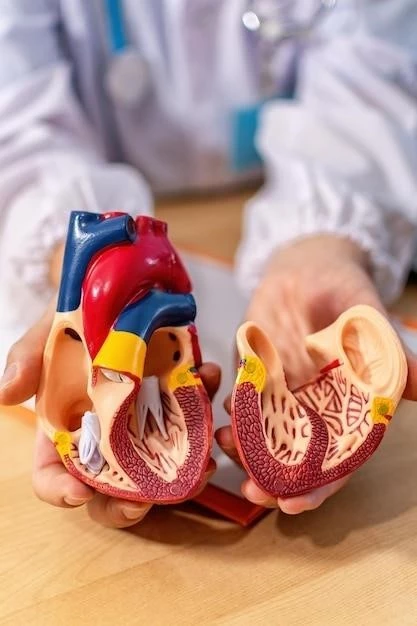Overview of Mitral Valve Prolapse (MVP)
Mitral valve prolapse (MVP) is a valvular heart disease characterized by the displacement of the mitral valve leaflet into the left atrium. It has familial clustering and can be X-linked.
Definition and Characteristics
Mitral valve prolapse (MVP) is a valvular heart disease where an abnormally thickened mitral valve leaflet displaces into the left atrium during systole, typical in myxomatous degeneration. Different types of MVP exist, such as classic and nonclassic, with severe cases leading to complications like mitral regurgitation. It is also known to have familial clustering and potential X-linked inheritance.
Familial Clustering of MVP
Mitral valve prolapse (MVP) often demonstrates familial clustering, with potential X-linked inheritance patterns observed in certain cases.
Barlow and Bosman’s Observation
Barlow and Bosman were among the first to report familial forms of late-systolic murmur and click, indicating a potential hereditary factor in the development of mitral valve dysfunction, highlighting the familial clustering of this condition.
Monteleone et al.’s Findings
In a study by Monteleone et al., a familial clustering of mitral valve prolapse (MVP) was noted in a small family, indicating a potential X-linked mode of inheritance in MVP cases within the family.
Mitral valve prolapse (MVP) is a common disorder affecting up to 2-3% of the general population. It is known to have familial clustering and potential X-linked inheritance patterns, with increased prevalence associated with a higher risk of complications such as ventricular arrhythmias and sudden cardiac death (SCD).
Prevalence in the General Population
Mitral valve prolapse (MVP) is a common disorder affecting up to 2-3% of the general population, with familial clustering and potential X-linked inheritance patterns observed in certain cases. It can be associated with an increased risk of complications such as ventricular arrhythmias and sudden cardiac death.
Autosomal Dominant Inheritance
Studies have suggested an autosomal dominant pattern of inheritance in familial MVP cases, indicating a hereditary component in the development of this condition.
X-Linked Inheritance
Research suggests a potential X-linked inheritance pattern in familial cases of mitral valve prolapse (MVP), indicating a genetic component in the transmission of this condition.
Recent Genetic Studies
Recent genetic studies have focused on investigating the hereditary components of mitral valve prolapse (MVP), shedding light on potential X-linked inheritance patterns observed in familial cases. These studies aim to elucidate the genetic basis of this condition through comprehensive analyses of familial MVP cases.
Clinical Manifestations of MVP
Mitral valve prolapse (MVP) can lead to complications such as mitral regurgitation, affecting the quality of life and health of individuals with this condition.
Complications and Risks
Mitral valve prolapse (MVP) can lead to complications such as mitral regurgitation, affecting the quality of life and health of individuals with this condition. Risks associated with MVP include an increased likelihood of ventricular arrhythmias and sudden cardiac death.

Research on Familial MVP
Research on familial mitral valve prolapse (MVP) has focused on investigating the genetic factors associated with the condition, particularly exploring potential X-linked inheritance patterns observed in familial cases.
Current State of Knowledge
Current research on familial mitral valve prolapse (MVP) has emphasized the understanding of genetic factors that contribute to the condition. Studies have specifically explored potential X-linked inheritance patterns observed in familial cases of MVP, enhancing our understanding of the hereditary aspects of this valvular disorder.
Recent advances in research have identified specific chromosomal loci linked to familial mitral valve prolapse (MVP). Studies have highlighted loci like FLNA and DCHS1, shedding light on the genetic factors associated with this condition.
Linkage to Chromosomal Loci
Recent genetic studies have identified specific chromosomal loci, such as the FLNA locus associated with an X-linked form of familial mitral valve prolapse (MVP), highlighting the genetic underpinnings of this condition’s inheritance patterns.
DCHS1 Locus and MVP Disease Gene
Advances in genetic research have identified the DCHS1 locus as a significant MVP disease gene. This locus has been linked to familial mitral valve prolapse (MVP), contributing to our understanding of the genetic basis of this condition’s inheritance patterns.
Importance of Nondiagnostic Morphologies (NDMs)
Nondiagnostic morphologies in familial mitral valve prolapse (MVP) play a crucial role as they may represent early expressions of the condition in genetically predisposed individuals. Understanding and identifying NDMs are essential for recognizing potential MVP cases.
Identification and Significance
Nondiagnostic Morphologies (NDMs) observed in familial cases of mitral valve prolapse (MVP) play a crucial role in identifying potential early expressions of the condition in genetically predisposed individuals. Recognizing and understanding the significance of NDMs is vital for the early detection and management of MVP.
Observations and pedigree analysis have provided insights into the autosomal dominant inheritance pattern of mitral valve prolapse, contributing to our understanding of the genetic basis of this condition.
MVP Inheritance Studies
Observations and pedigree analysis have provided insights into the autosomal dominant inheritance pattern of mitral valve prolapse, contributing to our understanding of the genetic basis of this condition.
Role of M-Mode Echocardiography
The role of M-mode echocardiography in familial mitral valve prolapse (MVP) studies has been significant, offering insights into the autosomal dominant inheritance pattern and aiding in further understanding the genetic basis of MVP.
Offspring of individuals with mitral valve prolapse (MVP) may have a higher prevalence of MVP if their parents exhibit the condition, highlighting potential familial inheritance patterns.

Prevalence of MVP in Offspring
Offspring of individuals with mitral valve prolapse (MVP) may have a higher prevalence of MVP if their parents exhibit the condition, highlighting potential familial inheritance patterns.
Clinical Implications of MVP
Endocarditis, heart failure, and sudden cardiac death are significant clinical implications associated with mitral valve prolapse (MVP), highlighting the importance of timely diagnosis and management of this condition.
Endocarditis, Heart Failure, and Sudden Death
Mitral valve prolapse (MVP) presents significant clinical implications such as endocarditis, heart failure, and an increased risk of sudden cardiac death. Understanding and managing these potential complications associated with MVP are crucial for ensuring optimal patient outcomes.
Research has identified genetic mutations associated with mitral valve prolapse (MVP), enhancing our understanding of the condition’s phenotypic classification and underlying pathogenesis.
Advances in Phenotypic Classification
Identification of genetic mutations associated with mitral valve prolapse (MVP) has contributed to advancements in the phenotypic classification of the condition, providing insights into its molecular and genetic underpinnings.
Incidence of MVP in Duchenne Muscular Dystrophy
A high incidence of mitral valve prolapse (MVP) has been reported in patients with X-linked Duchenne muscular dystrophy, highlighting a potential association between the two conditions.
Association with X-Linked Disorders
Mitral valve prolapse (MVP) has been reported to have a high incidence in patients with X-linked Duchenne muscular dystrophy, indicating a potential association between the two conditions and highlighting the need to understand the implications of such comorbidities.
Future Directions in MVP Research
Future research directions in the study of mitral valve prolapse (MVP) include further exploring the genetic mutations associated with the condition to enhance phenotypic classification and deepen our understanding of the molecular and genetic mechanisms underlying MVP, particularly in familial cases with potential X-linked inheritance.
